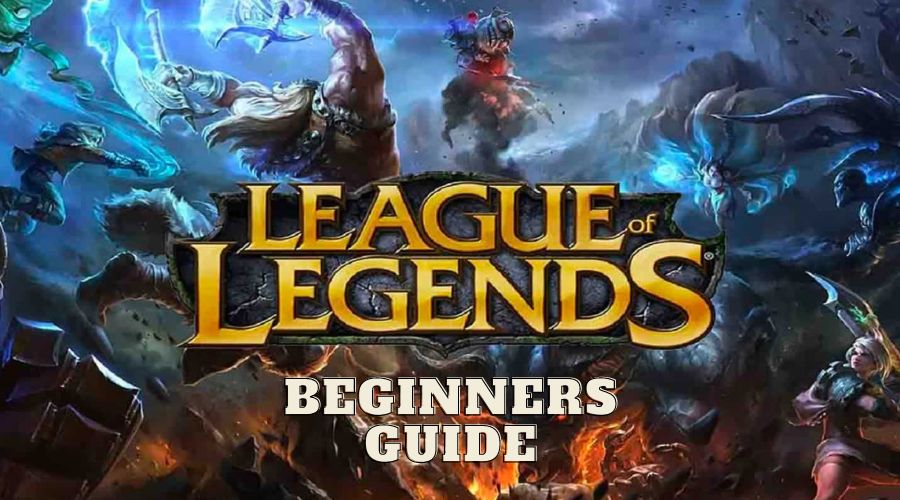League of Legends (LoL) welcomes newcomers with its complex yet thrilling gameplay. This beginner’s guide is designed to ease the overwhelming experience for those taking their first steps into this multifaceted gaming universe. Whether you are drawn in by the captivating world of “Arcane” or curious about the hype around TFT, understanding LoL’s fundamentals is crucial in navigating its intricate strategies.
The game’s steep learning curve, depicted vividly in high-stakes competitive matches like the LEC face-off between SK Gaming and Fnatic, underscores the depth of tactics and teamwork. Every move is part of a grand strategy, from meticulous Champion selections to coordinated manoeuvres. While simplifying these complexities, this guide seeks to empower beginners, offering solid groundwork for embracing the excitement and challenges that await in the vibrant realm of League of Legends.
What is League of Legends?
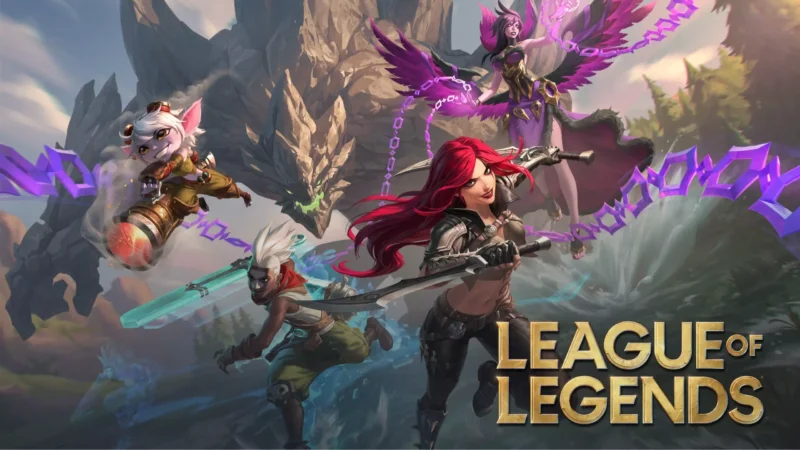
League of Legends, commonly known as LoL, is a highly popular multiplayer online battle arena (MOBA) game that pits two teams of five players against each other on a map called Summoner’s Rift. Each player controls a single character known as a champion, each with their unique set of abilities. The main objective is to destroy the enemy team’s Nexus, which lies at the heart of their base. To do this, players navigate through three lanes, battling enemy turrets, inhibitors, and Nexus turrets while managing minions that spawn and aid their team’s progress. The game combines strategic thinking, teamwork, and individual skills to secure victory.
The goal of League of Legends
The main objective in League of Legends is to destroy the enemy team’s Nexus, situated on the opposing side of the map. Despite the initial inclination to solely defeat opponents, the game involves strategic gameplay. Players empower their champions by earning experience and gold, which are achieved through various means like farming minions and taking down towers. While eliminating opponents is part of the strategy, the primary focus lies in tactical play to secure objectives. Destroying the enemy Nexus is the ultimate goal, but it involves navigating through defensive structures like turrets and inhibitors strategically placed to protect it. This objective-driven gameplay requires a combination of teamwork, strategy, and map control to achieve victory in League of Legends.
The Basics
Before starting a game in League of Legends, you will choose a game mode, typically Summoner’s Rift blind pick or the Howling Abyss. The more familiar and widely used map, Summoner’s Rift, allows players to select their champions and lane positions. On the other hand, the Howling Abyss features a smaller map with shorter gameplay where champions are randomly assigned. It is an ideal space for beginners to explore various Echampions and gameplay styles. Each mode offers a distinct experience, catering to different preferences and strategies, allowing players to delve into the diverse facets of the game.
1. Summoner’s Rift
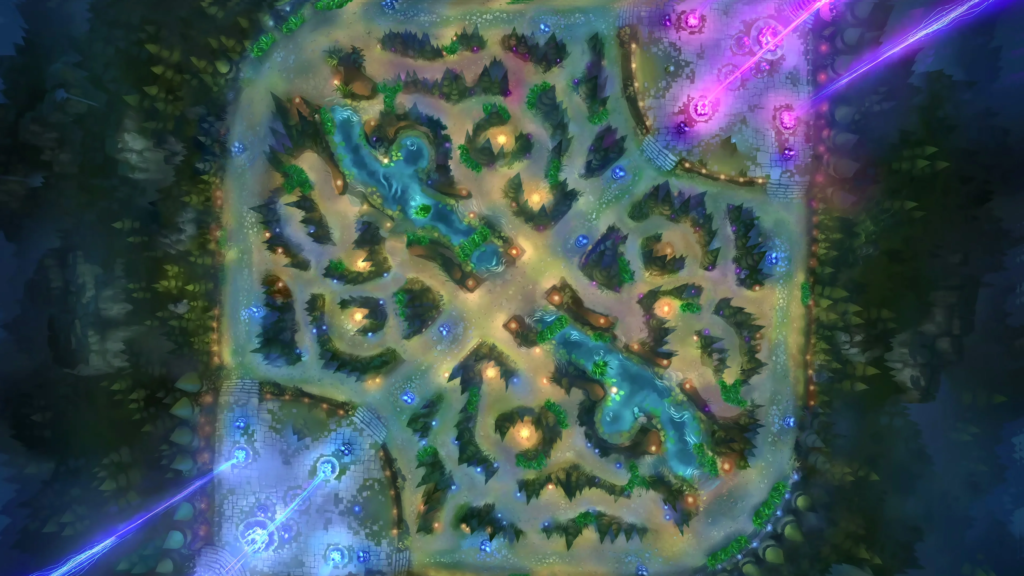
Summoner’s Rift is the main stage in League of Legends, where players battle to climb the rankings. It is the map you will spend most of your time on and where teams clash to destroy each other’s Nexus, which is like the core of their base.
The map has two blue and red teams, each with five players. They fight through three paths called lanes: top, mid, and bot. Along these lanes are towers that attack enemies. Players must destroy all towers in a lane to win and then take down the two towers guarding the enemy’s Nexus.
Summoner’s Rift is not just about lanes but also has a jungle area. This is where the fifth player on each team, called the Jungler, hangs out. Here, essential goals like Dragon, Baron Nashor, and Rift Herald exist, and teams must work together to claim them.
Different lanes suit different champion types: tanks and bruisers go top, mages and assassins hang out mid, while the bottom lane has two roles: ADC (Attack Damage Carry) and Support. The ADC deals damage from a distance, while the Support helps and protects them.
Lastly, the jungler roams the Jungle, taking down creatures and helping teammates in different lanes. Each role has more accessible champions for beginners, like Garen for top, Ahri or Zed for mid, Ashe or Jinx for ADC, and Soraka or Sona for Support, while Master Yi or Warwick are suitable for the Jungle.
2. Champion
In League of Legends, a champion is the character each player controls throughout a game. These champions are diverse, with over 150 unique options, each possessing distinct abilities and playstyles. Before a match starts, players select champions during champ select to build a cohesive team with complementary strengths and strategies. Each Champion comes with a passive ability, three standard abilities, and a potent ultimate ability that holds greater power but has a longer cooldown. Choosing a champion involves considering your preferred playstyle, cooperating with your team, and countering the opposing team’s composition. Essentially, champions are the cornerstone of gameplay, defining your role and impact within the game.
3. Summoner Spells and Runes
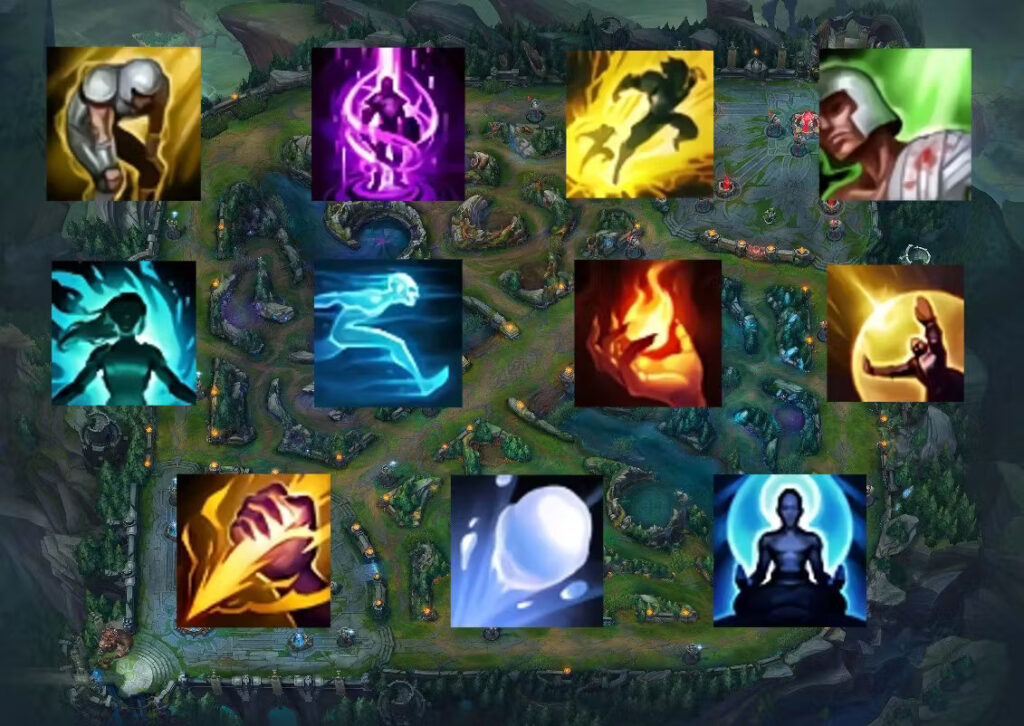
Summoner spells are additional abilities every player chooses before a game. They complement a champion’s unique skills, each with distinct benefits and lengthy cooldowns compared to champion abilities. Depending on their role and preferred playstyle, players select two summoner spells from a pool of options. For instance, ‘Heal’ provides health to the player and an ally, often favoured by ADCs or supports for sustainability. ‘Flash’ is a staple, enabling instant short-distance movement, universally embraced for its versatility in both offensive and defensive manoeuvres. Meanwhile, ‘Teleport’ aids in map control, allowing swift movement across the battlefield, predominantly used by solo laners or split-pushers. These spells significantly impact gameplay, offering diverse strategic advantages.
On the other hand, runes are like enhancements, grouped into distinct paths: precision, dominance, sorcery, resolve, and inspiration, each catering to specific playstyles. Players choose primary and secondary paths, selecting keystones and lesser runes that offer additional buffs based on their preferred path. For example, the Precision path empowers basic attacks, favouring champions relying on attack speed, while the Sorcery path boosts abilities, ideal for mages or supportive roles. These runes significantly affect a champion’s performance, granting buffs complementing their strengths and playstyle. Though choosing runes might seem complex, the standard rule aligning certain paths with specific champions helps, yet innovative rune choices can suit unique playstyles, challenging conventional strategies.
Gameplay Mechanics
1. Turrets and Inhibitors
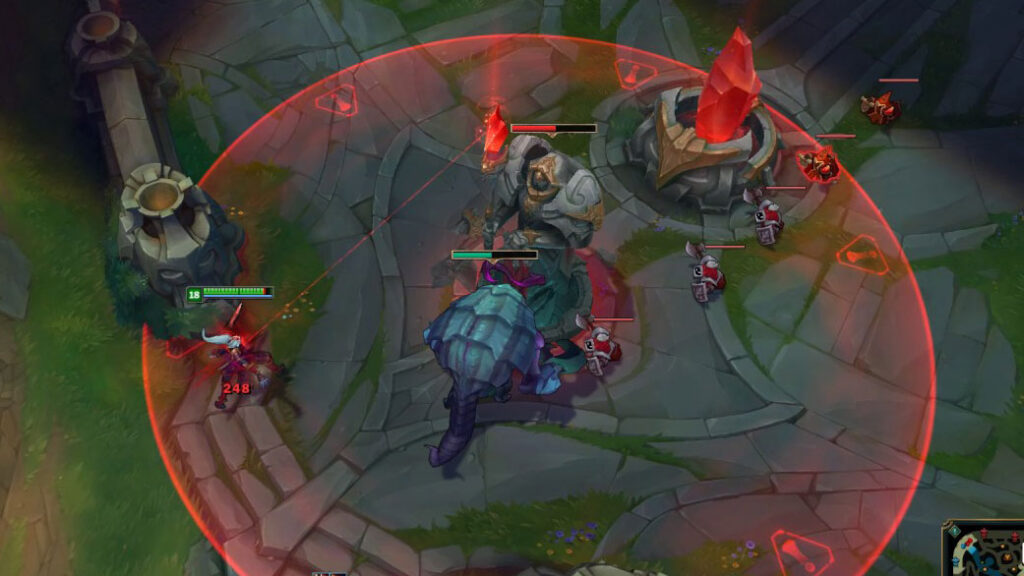
Destroying turrets and inhibitors is about gaining gold and a strategic move shaping the game. Turrets, found along the three lanes, serve as formidable defenses. There are three in each lane—outer, inner, and inhibitor turrets—each guarding a team’s territory. Taking down these turrets not only earns gold for the team but also paves the way for minion waves to advance, as without these defences, the minions can freely push through the lane towards the enemy base. Inhibitors, situated deeper within the base, when destroyed, spawn powerful Super Minions that can dramatically shift the game’s momentum, allowing teams to press their advantage and make a decisive push towards victory.
These structures, turrets, and inhibitors are not just obstacles but the guardians of the Nexus, the ultimate prize. While a team can secure victory by destroying as few as five turrets, most games require dismantling more defenses. Two turrets within the base safeguard the Nexus itself. Each structure plays a critical role in defense, offering vision and acting as barriers to protect team members. However, strategic destruction of these structures can tip the scales, creating opportunities for a team to breach defenses and claim victory on the Summoner’s Rift.
2. Minions
Minions play a crucial role in League of Legends, serving two vital purposes: farming and trading. Farming involves collecting gold by dealing the finishing blow to enemy minions, a fundamental method to strengthen your champions. These minions also grant experience, essential for levelling up your champions. While last-hitting minions are crucial to earning gold, being near dying minions grants experience, an important distinction that impacts gameplay.
Selecting positions in game modes allows players to designate primary and secondary roles, ensuring quicker matchmaking. An auto-fill system might assign players to less desired positions if needed, though this occurs infrequently. Swapping positions with teammates through chat is common if preferences align better.
3. Auto-attacks and Abilities
Champions wield both auto-attacks and unique abilities. Auto-attacks, or basic attacks, are triggered by right-clicking a target and continue until the target is defeated. Abilities are cast using Q, W, E, and R keys, each Champion possessing distinctive abilities for these buttons. Additionally, Summoner Spells, accessible through D and F keys, provide customizable abilities.
Champions can also utilize item-based abilities like Redemption and Tiamat, activated via number keys 1-7. As champions gain experience, they level up, allowing for ability upgrades. The ultimate ability (R) is the most powerful but is only unlocked at level 6. When abilities can be upgraded, an arrow icon appears above them, signalling a chance to enhance these skills.
4. Vision
Vision is essential in League of Legends, allowing you to keep tabs on enemy movements and safeguard against surprise attacks. Wards are the key to maintaining good vision on the map. The Warding Totem, an early-game sight ward, provides vision in a specific area for 90 seconds. Importantly, enemies cannot detect your vision unless they use ward-discovery items like Oracle Lens.
As the game progresses, additional ward types become available, each offering distinct levels of vision: Control Wards and Farsight Alteration. These wards maintain vision control throughout the game, granting insight into enemy positions and movements to aid in strategic decision-making.
5. Monsters
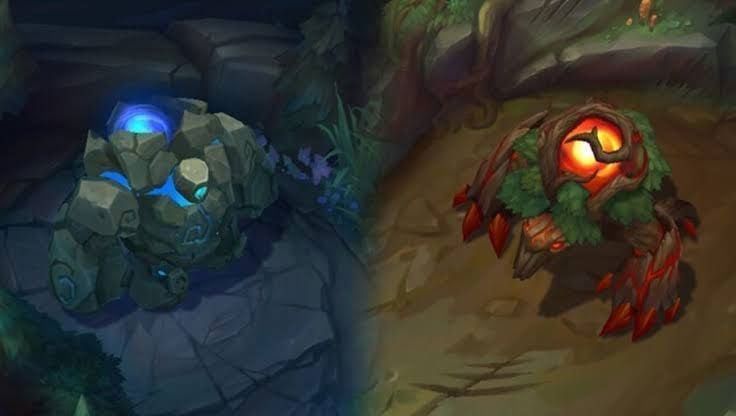
Gaining an advantage often involves defeating epic monsters, consisting of Rift Heralds, Dragons, and Baron Nashors. Rift Heralds spawn between the Top and Mid lanes, offering the team the powerful “Eye of the Herald” item when killed. This item summons the Rift Herald to attack enemy structures, providing extra gold and weakening defences.
Dragons, located in the Dragon Pit, come in various types, each offering unique buffs. Cloud, Mountain, Infernal, Ocean, and Hextech Drakes grant different advantages to teams when slain. Accumulating four Dragon kills grants the Dragon Soul, enhancing the team further while securing the fifth Dragon summons the potent Elder Dragon.
The Elder Dragon bestows the Aspect of the Dragon buff, empowering player attacks to inflict burning damage. It also allows for executing enemies with low health. Each dragon type influences the terrain, altering the map’s landscape and offering strategic advantages.
The Baron Nashor, located in the same pit as the Rift Herald is a formidable monster that grants immense benefits when defeated. Killing the Baron bestows the team with the mighty Hand of Baron buff, elevating their strength significantly. This buff enhances the team’s AD and AP, speeds up recalls, and strengthens nearby minions. Empowered recalls facilitate swift returns to base, while empowered minions become sturdier and deal increased damage. These empowered minions become a force to be reckoned with, quickly dismantling enemy structures. As the most potent monster in the game, defeating Baron Nashor requires teamwork, but the rewards it offers can swing the tide of battle and pave the way for victory.
Mastering these monster takedowns can significantly bolster a team’s power, leading to victory on the battlefield.
6. Minimap
The minimap in League of Legends, located at the bottom right corner of the screen, provides a condensed view of the current game map. It displays the real-time locations of your team’s champions and any visible enemy champions within your team’s vision range. This tool is a vital guide, helping you stay alert to potential threats across the map. However, it is important to note that any enemy champions hidden from your team’s vision won’t be revealed on the minimap, emphasizing the need for strategic map control and awareness.
7. Support
The Support role is often considered the easiest to start with but demands equal mastery to other roles. Paired with the ADC in the bot lane, Supports face a gold deficit as they do not earn gold from killing minions like the ADC. Instead, their primary focus is assisting the team and providing vision across the map.
Supports resemble Junglers in their team support duties but do not claim resources. They are generally categorized as enchanters, tanks, or mages. Enchanters focus on buffing and shielding teammates, requiring caution as they are less durable. Tanks prioritize protecting allies and initiating fights against opponents. Support mages, while not primarily healing or initiating, contribute by dealing damage and functioning as an additional carry for the team. Each subclass of Support brings unique strengths to aid the team’s success in different ways.
8. Structures
The ultimate objective is to destroy the enemy Nexus to secure victory. However, there are defensive structures like towers and inhibitors in your path. Towers primarily attack minions but target champions who attack under their range or when no allied minions are present. Destroying the towers opens the way to inhibitors, three of which exist, one in each lane for both teams. Inhibitors, unlike towers, don’t attack and destroying them spawns powerful allied Super minions in the respective lane, aiding in faster pushing.
To reach the enemy Nexus, you must eliminate all the defending towers in at least one lane and destroy at least one inhibitor. This paves the way to assault the Nexus and claim victory, marking the culmination of strategic gameplay and teamwork.
9. Gold and Items
Gold is crucial, earned through various in-game actions like defeating enemies or merely the passage of time. During the laning phase, killing minions is the primary means of acquiring gold, essential for purchasing items back at your spawn point.
While the game offers item recommendations based on your chosen Champion, understanding each item’s effects is valuable. Items bolster specific stats, and selecting the right ones to enhance desired attributes is vital to success. There is a wide array of items tailored to different needs. For instance, facing a mage as an ADC might prompt purchasing Quicksilver Sash for magic resistance, while a tanky Champion might opt for Spirit Visage for similar resistance along with tank stats.
Items significantly empower Champions by boosting their stats. Acquiring gold, earned from various sources like eliminating enemy champions, minions, jungle monsters, and structures, is essential for buying these items. Heading back to the fountain allows players to access the item shop and spend their earned gold. While some champions have recommended item builds, players can craft unique item combinations tailored to their strategy and playstyle, offering versatility in item selection and enhancing their chances of victory.
The Five Champion LoL Roles
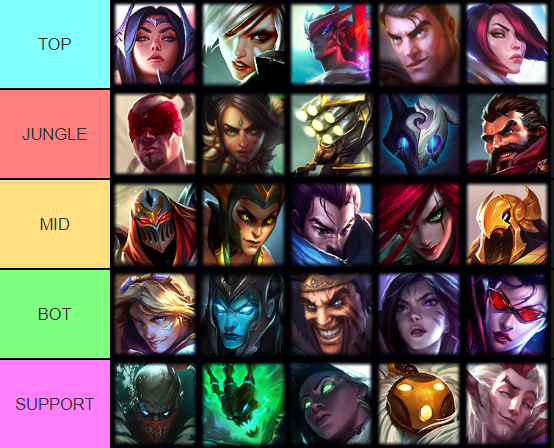
Each player on a team assumes one of five roles: Top, Jungle, Mid, ADC, or Support. Before a match, players pick a primary and secondary role or can opt to fill any position. New players are encouraged to explore all roles to understand their functions and find a preferred role.
Roles have specific expectations and champion types associated with them. Top lane often features fighters, Mid lane sees mages or assassins, Jungle accommodates tanks or fighters, Support entails healers or tanks, and ADC focuses on high damage output.
While champions can be played in multiple roles, the ” meta ” is a standard arrangement.” However, this can shift over time due to player experimentation. Starting with one role and gradually exploring others is recommended for beginners. Players are not restricted to a single role and can freely switch between them as they wish.
How to Win
Victory hinges on destroying the enemy Nexus located in their base. The Nexus stands shielded by two towers directly in front of it, safeguarded by three inhibitors, which are, in turn, protected by three towers. Each lane in the game leads to both teams’ bases, culminating in a tower and an inhibitor.
To breach the Nexus, at least one inhibitor must be destroyed. This requires taking down the towers guarding the respective objective, the inhibitors or the Nexus itself. Progressing towards the enemy base involves overcoming two towers in each lane before reaching the core defences.
League of Legends Beginners Tips
Getting started in League of Legends can be overwhelming. But fear not! Here are some foundational tips to help you navigate the game and improve your skills. These tips come from experienced players who have learned through trial and error, and they can significantly boost your understanding and performance in League of Legends.
- Stick with a Champion Initially: Focusing on one or two champions allows you to grasp their mechanics, strengths, and weaknesses more effectively, aiding in skill development.
- Utilize Online Resources: Do not stress over perfecting runes and item builds early on. Copying established rune setups and item builds from online guides can streamline your learning process.
- Explore Different Roles: While it is good to focus, try not to restrict yourself too early. Experimenting with various roles can help you understand the game’s dynamics better and find what suits you best.
- Do not Dwell on Mistakes: It is natural to make errors. Instead of dwelling on them, use them as learning opportunities to improve your gameplay gradually.
- Objective Focus: Prioritize objectives like towers, dragons, and barons. Understanding their importance and working with your team to secure them can swing the game in your favour.
- Learn from Others: Watching experienced players can offer insights into strategies, mechanics, and decision-making that you might overlook on your own.
- Optimize Gameplay Settings: Adjust settings like attack move click, timestamps, quick casting, and unlocking your camera to enhance your control and responsiveness in-game.
- Master Farming and Wave Control: Last-hitting minions and understanding how to manage waves can significantly impact your gold income and lane control.
- Continual Learning: Embrace the learning curve. Acknowledge mistakes, learn from them, and constantly seek improvement.
- Effective Communication: Learning the game’s language and communicating with your team, even if it is just through pings, enhances coordination and teamwork, fostering better gameplay experiences.
Conclusion
The journey into League of Legends as a beginner can feel overwhelming, but with time, the basics will become natural. The Ultimate Beginner’s Guide aims to kickstart your understanding of this expansive game. League of Legends has a vast following worldwide, and while this guide covers just the basics, it forms a crucial foundation. Patience is key; rushing into ranked matches without experience is not advised. Focus on mastering fundamentals, then specialize in roles or champions. Whether you are a champion or become a dedicated specialist, League of Legends is about continuous learning and practice. Embrace the complexity, enjoy the learning curve, and relish your progress on Summoner’s Rift!
